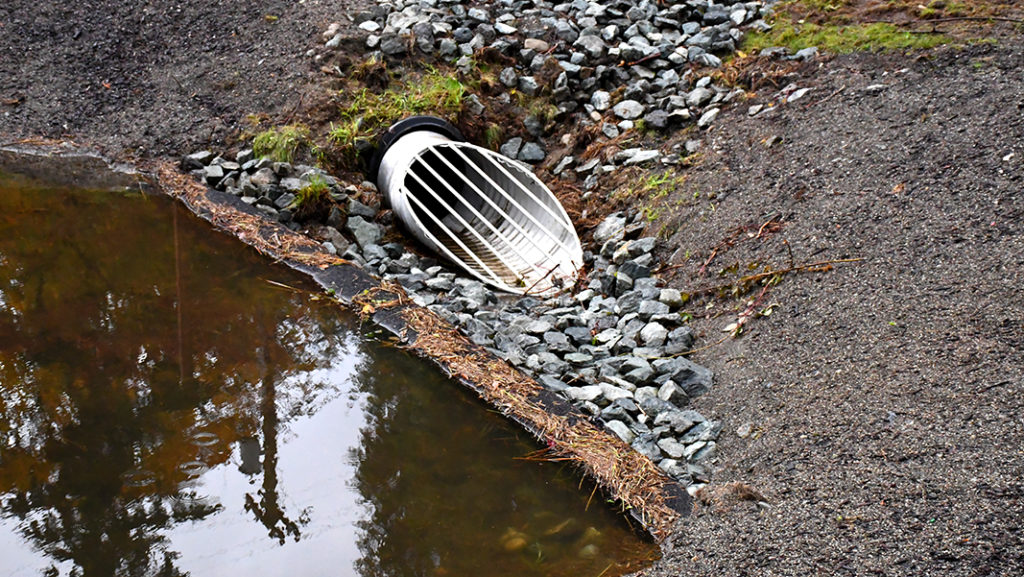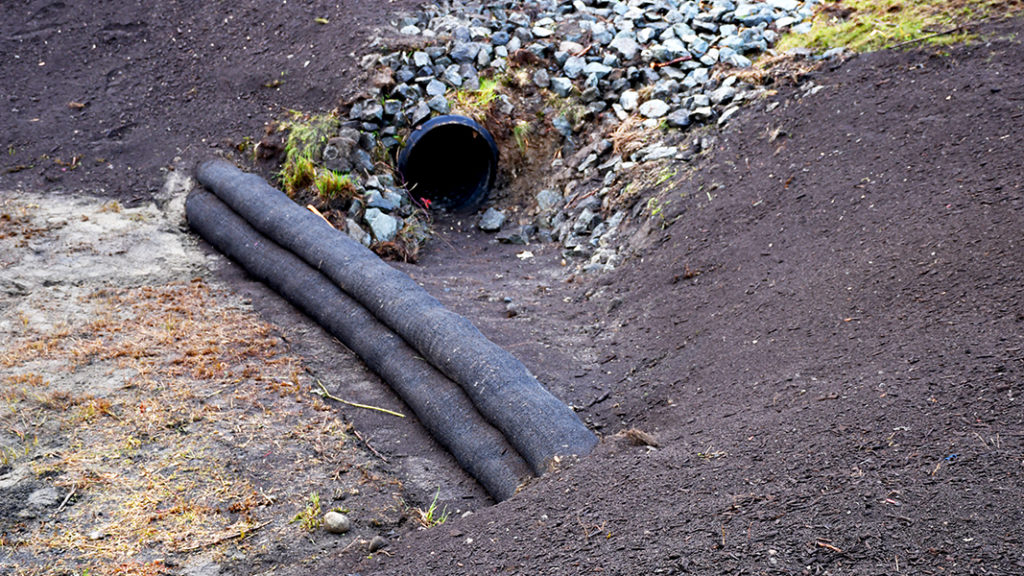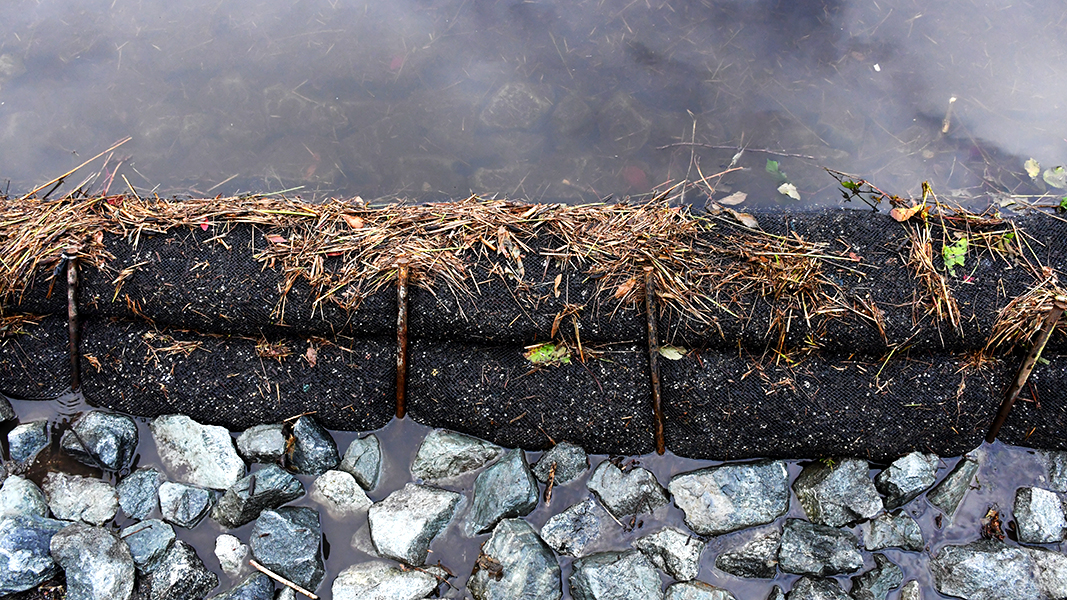Top: BURitos technique utilized by City of Bellevue and Washington State University researchers at an urban storm water detention pond.
Nora Goldstein
The Soils For Salmon program, initiated in 1999 by the Washington Organic Recycling Council and Snohomish County, was designed to address the harmful impacts of storm water runoff on salmon habitat, primarily into streams that feed into the Puget Sound in western Washington. The streams serve as spawning grounds for the salmon. The sediment, pollutants, and temperature of surface runoff were endangering salmon and other aquatic species. BioCycle documented the research and initiatives that evolved out of the Soils for Salmon program — one of the first to connect use of compost in amending soils and in biofiltration media as effective remediation and pollution prevention tools.
While methods that incorporate compost for storm water management and filtration have been proven successful, an ongoing challenge is finding locations in urban areas to install biofiltration infrastructure in a practical and economical manner. Several years ago, storm water managers at the City of Bellevue and researchers at Washington State University (WSU) undertook a study to address that challenge. A $175,625 grant was received from King County (WA) WaterWorks to fund the project, which focused on retrofits of existing untreated areas, beyond redevelopment projects, using a simple method of implementing the retrofits. They ultimately landed on an older publicly owned detention pond in the City of Bellevue, Washington to pilot test the performance of biofiltration media to improve water quality and prevent toxicity from storm water runoff.
Study Methods
A report on the research findings was released in July 2021; the lead author is Jenifer McIntyre, one of the WSU researchers. Titled “Roads to Ruin: Will Water Quality Retrofits Save Salmon?,” the report details study methodology and findings, and includes numerous charts and graphs that present findings of storm water sampling, water chemistry and toxicology. This article summarizes the findings based on excerpts from the report.

The selected urban storm water retention pond collects approximately 20 acres of runoff from a single-family neighborhood that includes a minor arterial roadway. Photos by Chris Cunningham, Cedar Grove Composting
Criteria used to select a detention pond were that it had a suitable inflow from a nearby busy arterial; the ability to easily access, as well as perform the necessary modifications; and a suitable area for collecting inflow/outflow before and after treatment. Influent storm water to the detention pond was tested for toxicity to zebrafish embryo prior to confirming site selection. Researchers selected a pond that is approximately 2,500 square feet during low flow/normal operations with an overflow footprint of approximately 3,800 square feet. The pond collects approximately 20 acres of runoff from a single-family neighborhood that includes the minor arterial (as defined by the city’s transportation plan).
Researchers named the project BURitos — Bioretention Urban Retrofits. The concept, explains McIntyre, “was to use rolls of bioretention media perpendicular to the direction of flow in the detention pond to provide treatment similar to that for gravity-fed bioretention installations. However, we discovered that the standard Washington State specified bioretention media (60% sand + 40% compost, by volume) is too dense to treat runoff flowing laterally. In pilot tests with BURitos filled with bioretention media, water built up behind the roll and eventually flowed over, around, or under the BURitos rather than being filtered through the media. …. A subsequent test of media composed of 60% coarse sand and 40% medium compost leached with clean water produced no mortality or sublethal impairments. This media was selected for use in the BURitos. The sand was an unwashed screened utility sand.”
High-density polyethylene (HDPE) socks, 12 inches in diameter, were laid out and filled in place by Cedar Grove Composting. Notes the report, “the socks were keyed in to secure them from movement or water bypassing beneath or around them. A small collection depression was excavated to provide access for sampling. One set of 3 stacked BURitos was placed at the head of the pond whereas the second set was placed at the tail of the pond. Maintenance included mowing vegetation around the BURitos, minor grading in front of each BURito to remove built-up sediment, and minor sock repair.”
City of Bellevue staff collected samples at the pond for toxicity testing and quantitative chemical analysis for a suite of parameters. The intent was to collect grab samples at the beginning of a storm event at the inlet to the pond (influent; INF), after the first set of BURitos (BUR1) and after the second set of BURitos (BUR2). A qualifying storm event was considered to be a minimum antecedent dry period of 24 hours. Water samples were submitted for chemical analysis to a commercial analytical chemistry laboratory. Water was analyzed for a suite of conventional analytes (ammonia, dissolved organic carbon (DOC), total suspended solids (TSS)), metals (dissolved Cu and Zn), nutrients (nitrates (NOx), total phosphorus (TP)), 21 polycyclic aromatic hydrocarbons (PAHs), and six phthalates.
Results And Conclusions
Sampling and toxicity data are presented in detail in the report. “The retrofit detention pond generally improved the quality of storm water runoff; water leaving the pond had lower concentrations than influent runoff for 79% of cases (analytes x events),” writes McIntyre. “Most of that benefit was provided by BUR1; concentrations were reduced by BUR1 for 85% of cases, whereas BUR2 provided additional concentration reduction in only 56% of cases. …. The improvement in water quality at BUR1 was statistically significant across the entire study for dissolved zinc, pentachlorophenol, dimethylphthalate, total phosphorus, and nitrates.”

Installation of BUR-1 at the inflow of the storm water detention pond. A small collection depression was excavated to provide access for sampling.
The report notes that water passing through BUR2 had interacted with the pond itself prior to being treated by BUR2 at the end of the pond. “A fair assessment of the benefit provided by BUR2 would have required taking an additional water sample just prior to BUR2. It is possible that water treated by BUR1 picked up contaminants from the pond itself prior to treatment at BUR2, reducing the apparent effectiveness of the BURito treatments for the pond as a whole. … A sample of water immediately prior to BUR2 treatment would have prevented the uncertainty around whether the pond itself contributed to treatment and/or pollution of runoff. A better assessment would be sampling influent and effluent waters from an existing detention pond before and after BURito installation across comparable time periods (e.g. 6-12 months).”
The retrofit detention pond “significantly improved” the morphometric indicators of acute toxicity. The average improvement across events was 80% for zebrafish embryo eye area and 89% for pericardial area. Most of this benefit was attributable to treatment at BUR1, with a 55% improvement in eye area and a 52% improvement in pericardial area.
In addition, the retrofit storm water detention pond “provided good removal of most targeted pollutants and prevented acute toxicity,” explains the report. “Because runoff was being treated by lateral flow through the coarse BURito media, we expected that BURito performance would be more comparable to bioswale performance than to bioretention treatments that rely on gravity flow through a finer media. However, removal of dissolved metals and organic matter was intermediate to that of bioretention and bioswales. On a contact time basis, this result makes sense because treatment flow through a single BURito was approximately 0.5-4.0 horizontal cm/min, which is similar to that of bioretention (0.5-1.5 vertical cm/min) … Less nitrates leached from the BURitos than from bioretention, which may be related to the use of coarser compost-containing media (lower surface:volume for leaching).
“Additional study is needed to evaluate the contact time (including surface area) between these treatment approaches to better understand their relative performance. Finally, the BURitos showed a wide range in treatment of TSS, with export in 2020 and high removal in 2021 (~50% export up to ~100% removal). More testing is needed to assess whether TSS is effectively treated by the BURitos. Unlike water chemistry performance, reduction of toxicity provided by the BURitos was better than for bioswales and on par or even better than for bioretention.”
The researchers explain that the primary toxicant driving acute mortality in Coho Salmon exposed to roadway runoff is 6PPD-quinone. Zebrafish is a less sensitive species. “Among the contaminants measured in this study, pentachlorophenol (PCP) might be most comparable to 6PPD-quinone as it is an aromatic hydrocarbon with similar hydrophobicity. PCP was reliably removed by the retrofit pond (median removal ~80%), with the bulk of the removal occurring at the first BURito. Overall, these pilot test results support that one BURito was better than none (BUR1 vs influent water chemistry and toxicity), and that two BURitos generally provided better treatment than just one.”
Some key design parameters that need to be defined based on this research study are:
- Flow rate accommodated by a BURito as a function of BURito diameter
- Treatment level as a function of flow rates
- Total volume treated by a BURito (life span)
- Inspection/maintenance requirements
- Rate of sediment build up upstream of a BURito and its effect on treatment level
- Volume of runoff treated vs. overtopping BURitos for storms of different sizes
- Sizing of BURitos: How many are needed to effectively treat a pond based on maximum flow rates, contributing area, and treatment area?
The report concludes: “We believe that retrofitting existing detention ponds with BURitos should be evaluated as a future best management practice. The cost of pond retrofit was approximately $15,000 including inlet modification, biofiltration berm construction, and labor costs. Given the relatively low operations and maintenance cost of the BURitos, this pond retrofit is a cost-effective water quality treatment compared to installing new water quality retrofit storm water facilities in the right-of-way. We believe it is feasible to annually incorporate the retrofit of one or more ponds into existing programs through routine work and budgets given the existing requirement under NPDES Municipal Permits to inspect and maintain existing storm water detention ponds.”
“Roads to Ruin: Will Water Quality Retrofits Save Salmon?” can be downloaded at this link.















